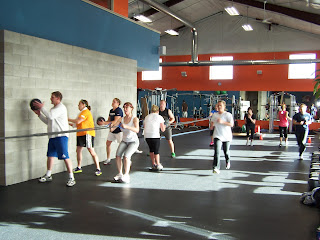Why we do it the way we do...
Why we do it the way we do…
We trainers all have our own way of doing things. We are
nothing if not passionate about what we do. Most of us believe that the way we
do things is the best way. We have seen it work in our own bodies and the
bodies of our clients and have learned what works and what doesn’t work. And
there are some definite reasons why I do things the way I do.
Today I got some good feedback because my class was hard.
People liked it and they worked their butts off. When I sat down to build the
workout my plan was “make it hard”…. It got the job done.
But there is a reason why not every workout I do is so hard.
It doesn’t always have to be hard to be effective. There are many exercises out
there that have a purpose besides inducing your gag reflex and making you sore
for the entire weekend.
There are many days that I sit down and plan a workout with
a plan to “improve their coordination” or “increase their core awareness” or
“improve their cardio endurance”. Sometimes these workouts aren’t as physically
hard as the others.
Here is why:
In very basic
terms we have two types of muscles; the big ones and the little ones. I am not
talking quads versus calves here either. The big muscles are the ones we see
and are aware of as we lose fat and gain lean mass… the quads, glutes,
deltoids, biceps, pectorals, lats, calves… Here is a picture to get the idea.
The “hard” workouts support the big muscles, they don’t take
much thought to challenge and can make a person feel like they will die, or
then wish they would die. These workouts are great for building fitness,
burning calories, and giving your ego a boost (or a hit, depending on your
perceived fitness level).
It is the other workouts that are more challenging to create
and make effective.
The little muscles are the ones that we need to keep us
feeling great as we age. They are the postural muscles, the true internal core
muscles, the muscles that support your neck and your spine and your shoulders
and your ankles.
These are the muscles that allow NFL receivers to stop and
start in the blink of an eye. These are the workouts that save your butt when
you take a misstep jumping rope or fall down a flight of stairs, or step off a
curb funny while walking down the street. These “small muscle” workouts keep us
HEALTHY and uninjured and able to complete those hard workouts in a safe
manner.
So next time your trainer gives you an “easy” workout. Thank
them for teaching your body to take care of itself and stay injury free for
many workouts to come.








CAryn!!!! soo very well said!!! thank you soo much - I need all of my clients to read this! one I'm speaking of especially! ;)
ReplyDeleteThanks Molly!
ReplyDelete